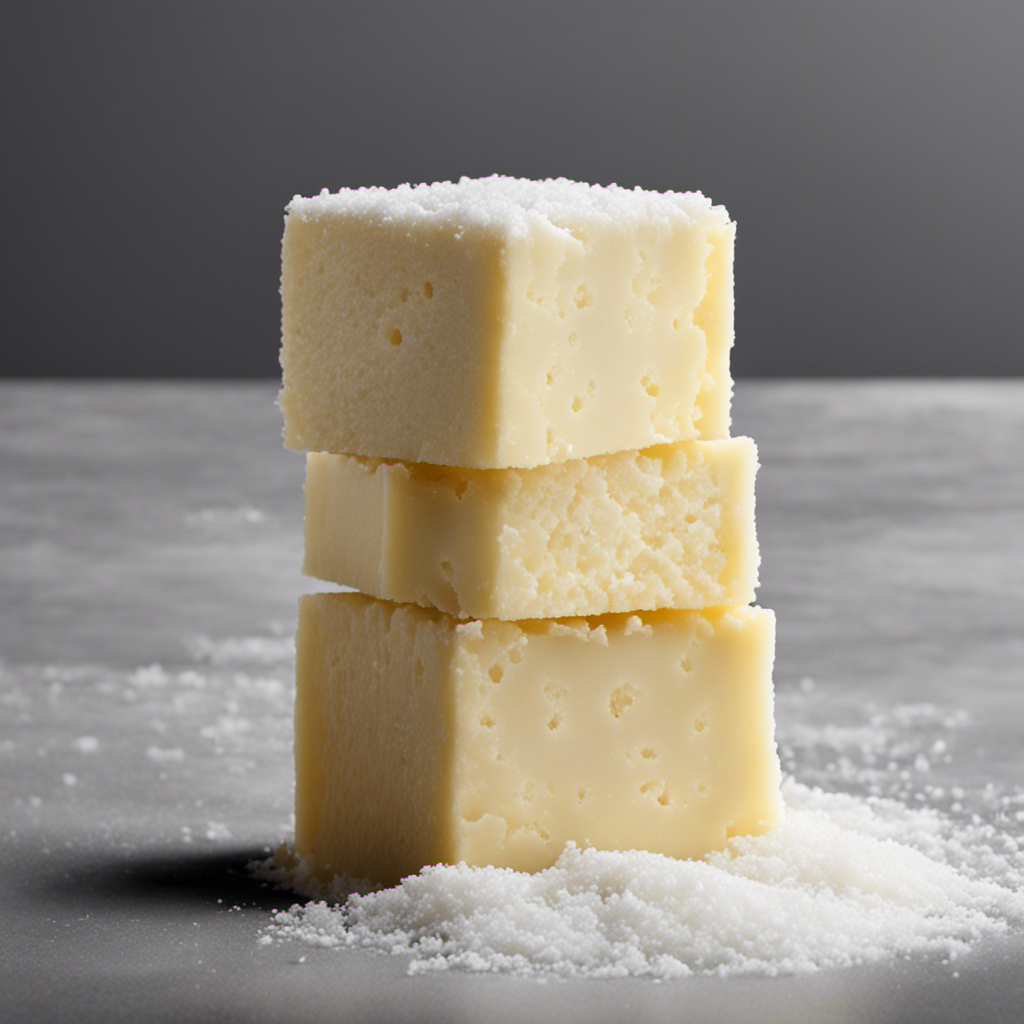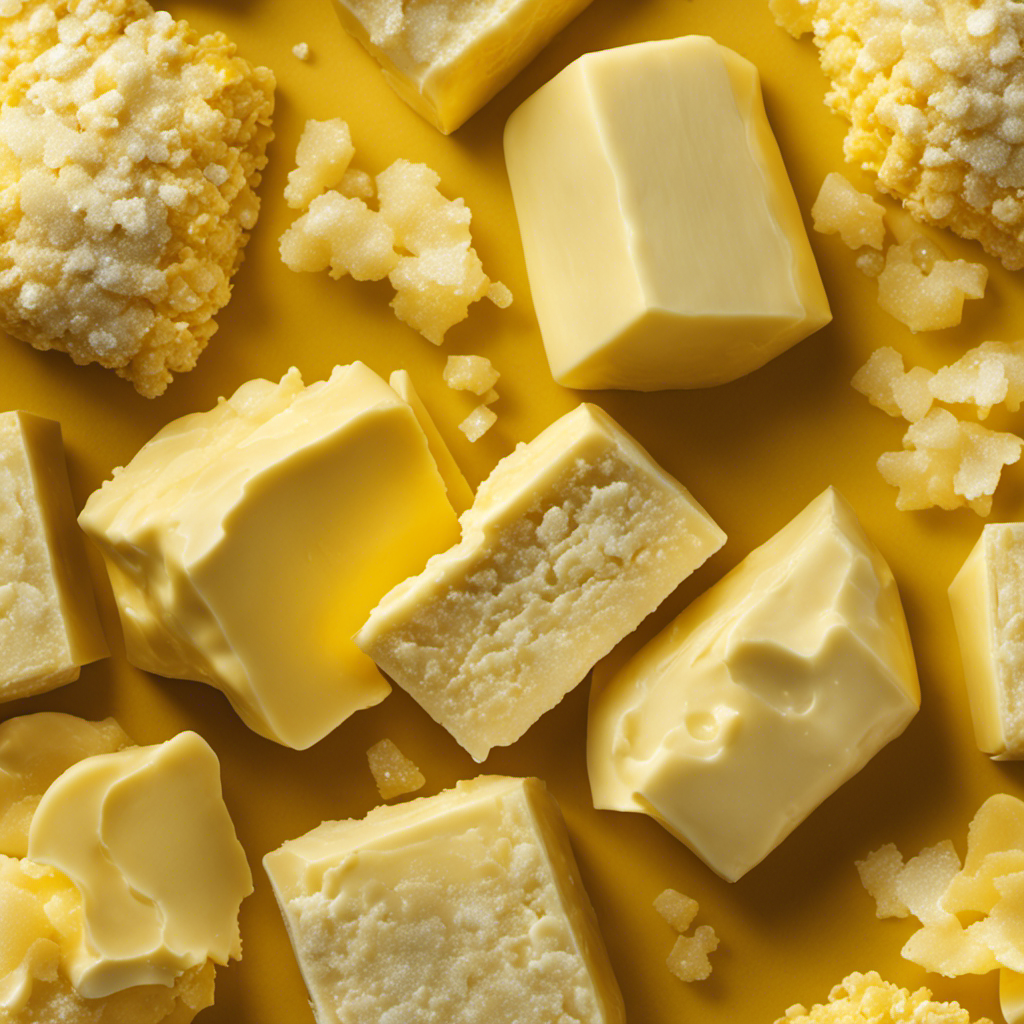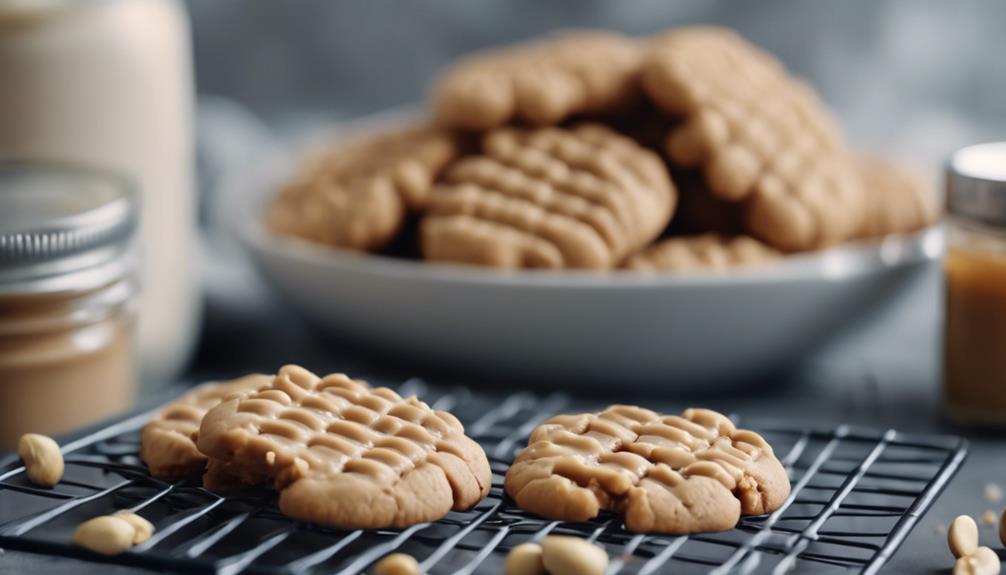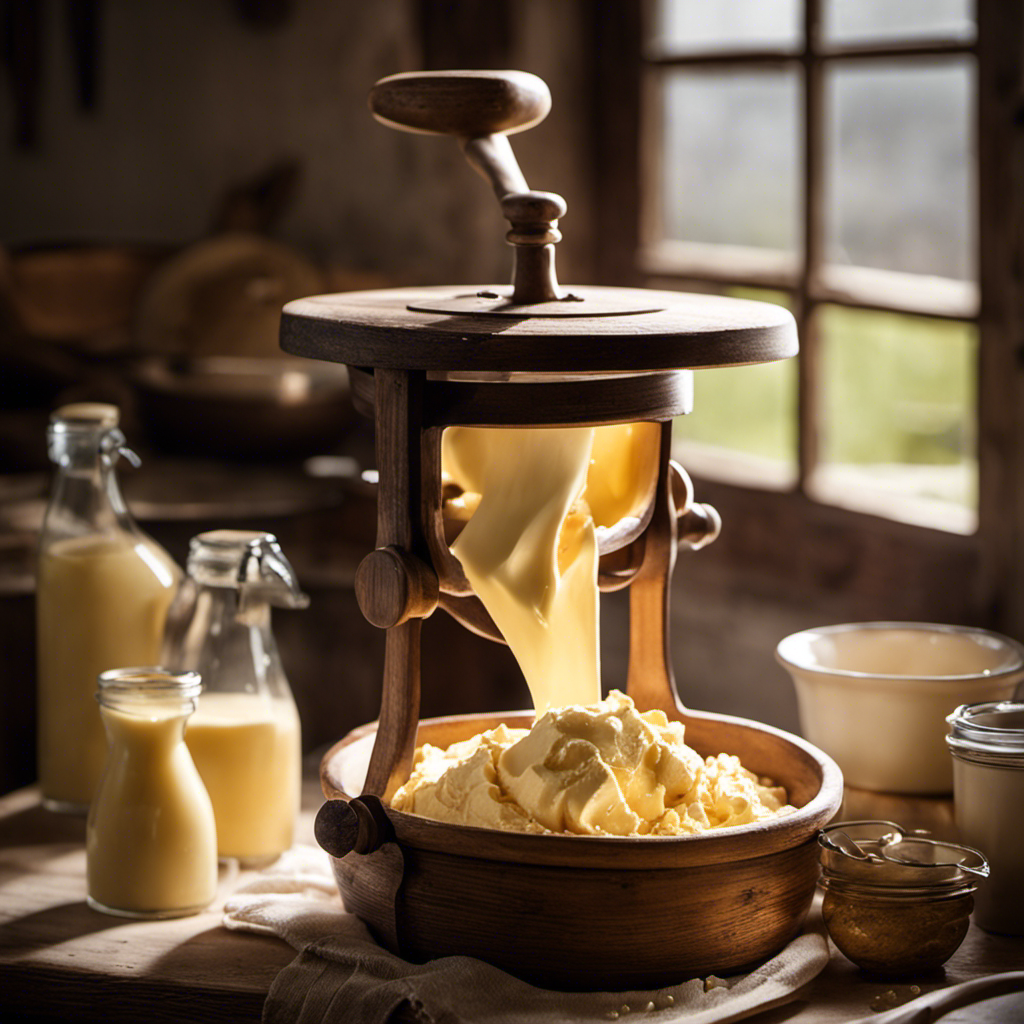Just like a blank canvas ready to be transformed into a masterpiece, unsalted butter has the potential to turn into a flavorful and versatile ingredient.
But how much salt should be added to turn it into the beloved staple of every kitchen – salted butter?
In this article, I will delve into the science behind the salt-to-butter ratio, offer guidelines for baking and cooking, and explore the various flavors and dietary considerations.
Get ready to unlock the secrets to perfecting your own homemade salted butter creations.
Key Takeaways
- Salt enhances flavor and acts as a preservative in salted butter.
- The salt-to-butter ratio should be adjusted to suit personal taste preferences.
- Consideration of intended use and health benefits is important before adding salt to butter.
- Experimenting with different flavors can create customized salted butter variations.
The Science Behind Salted Butter
To understand the science behind salted butter, you should know that the addition of salt not only enhances the flavor but also helps preserve the butter.
Salted butter is made by incorporating salt into unsalted butter during the churning process. The amount of salt added can vary depending on the desired taste, but it typically ranges from 1-3% of the butter’s weight.
The role of salt in butter goes beyond just adding flavor. Salt acts as a preservative by inhibiting the growth of bacteria and other microorganisms that can cause spoilage. It also helps to stabilize the structure of the butter, preventing excessive softening or melting.
Additionally, the salt in butter can enhance the aroma, texture, and overall sensory experience of the final product.
Understanding the Salt-to-Butter Ratio
When making salted butter, you’ll want to ensure that the ratio of salt to butter is just right. The right amount of salt can greatly enhance the flavor of the butter and make it perfect for baking or spreading on toast.
Here are a few things to keep in mind when determining the salt-to-butter ratio:
-
Start with unsalted butter: Using unsalted butter as a base allows you to control the amount of salt added and ensures consistency in flavor.
-
Taste as you go: Add salt gradually and taste the butter along the way. This will help you achieve the desired level of saltiness without overdoing it.
-
Consider the recipe: The importance of salt in baking cannot be overstated. It helps to balance flavors, enhance sweetness, and even improve texture in certain recipes.
-
Experiment and personalize: Everyone’s taste preferences vary, so feel free to adjust the salt-to-butter ratio to suit your own taste buds. Just remember to keep it balanced and enjoy the flavorful results!
Factors to Consider Before Adding Salt
Consideration should be given to the impact of different factors before incorporating salt into the butter.
There are several factors to consider when deciding how much salt to add to unsalted butter. First, it is important to consider personal taste preferences. Some people may prefer a more subtle saltiness, while others may enjoy a stronger flavor.
Additionally, the intended use of the salted butter should be taken into account. If the butter is being used in baking, a higher salt content may be desired to enhance the flavors of the baked goods. On the other hand, if the butter is being used for spreading on toast or other dishes, a lower salt content may be preferred.
Finally, it is worth noting the potential health benefits of adding salt to unsalted butter. Salt can enhance the flavor of food and also act as a natural preservative, extending the shelf life of the butter.
In conclusion, considering personal taste, intended use, and potential health benefits are important factors to consider before incorporating salt into the butter. This can help ensure that the final product is tailored to individual preferences and needs.
Now, let’s explore the next section and delve into experimenting with different salted butter flavors.
Experimenting With Different Salted Butter Flavors
You can start experimenting with various flavors to create unique variations of butter. Here are some ideas to inspire you:
- Garlic and Herb: Mix in minced garlic, dried herbs like thyme or rosemary, and a pinch of salt for a savory spread.
- Cinnamon Sugar: Blend in ground cinnamon and sugar for a sweet and fragrant butter, perfect for toast or pancakes.
- Chili Lime: Add a kick to your butter by combining lime zest, chili powder, and a touch of salt for a tangy and spicy twist.
- Honey Almond: Stir in honey and chopped almonds for a rich and nutty butter that pairs well with breads and pastries.
By taste testing different salted butters with these different seasoning combinations, you can discover your favorite flavors. These variations can be used in cooking, spreading on bread, or as a topping for vegetables.
Now, let’s explore the guidelines for using salted butter in baking.
Guidelines for Salted Butter in Baking
When it comes to baking, salted butter is often the go-to choice for adding flavor and richness. However, there are times when you may need to explore alternatives to salted butter, whether due to dietary restrictions or personal preference.
In addition, understanding the proper distribution of salt in your baked goods is crucial to achieving the perfect balance of flavors.
Let’s dive into the discussion on salted butter alternatives and the importance of proper salt distribution in baking.
Salted Butter Alternatives
If you’re looking for a substitute for salted butter, there are a few alternatives worth considering. While salted butter is commonly used in baking, there are other options that can provide similar results. Here are some alternatives to salted butter:
-
Margarine: Margarine is a popular substitute for salted butter in baking. It has a similar texture and can be used in equal amounts in most recipes.
-
Unsalted Butter with Salt: If you have unsalted butter on hand, you can simply add salt to it to make it salted. Start with a 1/4 teaspoon of salt for every 1/2 cup of butter and adjust according to your taste.
-
Ghee: Ghee is clarified butter and can be a great substitute for salted butter. It has a rich flavor and can enhance the taste of your baked goods.
-
Coconut Oil: Coconut oil is a plant-based alternative to salted butter. It adds a subtle coconut flavor and works well in many baking recipes.
These alternatives can help you achieve the desired flavor and texture in your baked goods, even if you don’t have salted butter on hand. Now, let’s discuss the importance of proper salt distribution in baking.
Proper Salt Distribution?
Proper salt distribution is essential for achieving the desired flavor and texture in baked goods. When it comes to baking, simply adding salt to the batter or dough is not enough. The salt needs to be evenly distributed throughout the mixture to ensure that every bite has the perfect balance of saltiness.
Achieving the desired saltiness requires careful measurement and thorough mixing. I recommend measuring the salt accurately using a kitchen scale or measuring spoons. Then, incorporate the salt into the dry ingredients and mix well before adding any liquid ingredients. This will help distribute the salt evenly and prevent any pockets of saltiness or blandness in your baked goods.
Now, let’s move on to the next topic: using salted butter for sautéing and cooking.
Salted Butter for Sauteing and Cooking
For sautéing and cooking, adding salt to unsalted butter will give you salted butter. It’s a simple way to enhance the flavor of your dishes and add a savory touch to your cooking. Here are some benefits of using salted butter for sautéing:
-
Provides a balanced seasoning: Salted butter already contains salt, so you don’t have to worry about adding extra salt separately.
-
Enhances the flavors: The combination of butter and salt brings out the natural flavors of the ingredients, making your dish more delicious.
-
Adds depth to the dish: The salt in the butter helps to deepen the overall taste of the dish, making it more satisfying.
-
Versatile in recipes: Salted butter can be used in a wide range of recipes, from savory dishes to baked goods, adding complexity to your culinary creations.
By using salted butter for sautéing, you can ensure that your dishes are seasoned well and have that extra burst of flavor.
Now let’s explore how salted butter can further enhance the flavor of your dishes.
Enhancing Flavor With Salted Butter
When it comes to enhancing flavor in my cooking, one of my go-to ingredients is salted butter. Not only does it add a rich and savory taste to dishes, but it also brings out the flavors of other ingredients.
However, there are times when I run out of salted butter and need a substitute. In this discussion, I will explore the benefits of using salted butter in cooking and provide some alternatives for when it’s not available.
Salted Butter Benefits
One of the benefits of salted butter is that it adds a savory flavor to dishes. Salted butter contains salt, while unsalted butter does not. This difference impacts both the taste and the health implications of using these two types of butter.
Here are some key points to consider:
-
Enhanced flavor: Salted butter adds a delicious savory taste to dishes, making them more flavorful.
-
Convenience: Salted butter eliminates the need to add additional salt to your recipes.
-
Preservation: The salt in salted butter acts as a natural preservative, extending its shelf life.
-
Moderation: It’s important to consume salted butter in moderation, as excessive salt intake can have negative health effects, such as high blood pressure and water retention.
Substitutes for Salted Butter?
If you’re looking to switch up your butter options, there are several substitutes available that can still add flavor to your dishes.
While salted butter is commonly used for its savory taste, unsalted butter can be a healthier alternative. Unsalted butter is free from added salt, which can be beneficial for those watching their sodium intake. Additionally, unsalted butter allows you to have more control over the amount of salt added to your recipes.
To give your dishes a similar taste to salted butter, you can simply mix in a pinch of salt to unsalted butter. This way, you can enjoy the flavor of salted butter while still maintaining the health benefits of unsalted butter.
Now, let’s explore the use of salted butter in homemade spreads and sauces.
Salted Butter in Homemade Spreads and Sauces
To make your homemade spreads and sauces with salted butter, simply add the desired amount of salt to the unsalted butter and mix well. It’s a simple and effective way to give your recipes a delicious salty kick.
Using salted butter in baked goods can elevate the flavors, adding a savory element to sweet treats like cookies or cakes. But besides the taste, there are also health benefits to using salted butter.
The sodium in salted butter helps regulate fluid balance in the body and supports nerve function. It also aids in the absorption of certain vitamins and minerals.
Adjusting Salted Butter for Dietary Restrictions
When adjusting for dietary restrictions, you’ll want to consider the sodium content in the butter you’re using. For individuals with heart health concerns, it becomes crucial to find low sodium alternatives to regular salted butter.
While salted butter adds flavor to dishes, it can also contribute to high blood pressure and other cardiovascular issues due to its sodium content. To adjust salted butter for heart health, one option is to switch to unsalted butter and add a pinch of low sodium salt to achieve a similar taste without the excessive sodium.
Another alternative is to explore low sodium butter options available in the market. These alternatives offer a reduced sodium content while still providing the rich, creamy taste of butter.
Benefits of Using Salted Butter in Everyday Cooking
Using salted butter in everyday cooking offers a range of benefits that enhance the overall culinary experience.
Firstly, its addition provides an enhanced flavor profile to dishes, adding a subtle salty note that complements a variety of ingredients.
Secondly, the use of salted butter allows for precise control over seasoning, as the amount of salt in the butter can be adjusted according to personal taste preferences.
Lastly, the versatility of salted butter shines through in various dishes, from savory recipes like roasted vegetables to sweet treats like cookies, making it a valuable ingredient in the kitchen.
Enhanced Flavor Profile
Adding salt to unsalted butter enhances its flavor profile. The simple act of seasoning the butter with salt can elevate its taste and make it more enjoyable to use in various recipes. Here are a few reasons why this cooking technique can result in a flavor enhancement:
-
Balances the richness: Salt helps to cut through the richness of the butter, providing a well-rounded flavor experience.
-
Accentuates other ingredients: The addition of salt brings out the flavors of other ingredients in the dish, making them more pronounced and satisfying.
-
Adds depth: Salt adds depth and complexity to the overall taste of the butter, making it more interesting and delicious.
-
Improves mouthfeel: The salt enhances the texture of the butter, giving it a smoother and creamier feel on the palate.
Ease of Seasoning Control
It’s easier to control the level of seasoning in butter when we start with unsalted butter. By using unsalted butter as a base, we have the freedom to customize the flavor according to our preferences.
Whether we want a hint of salt or a bold, savory taste, we have complete control over the seasoning process. This ease of seasoning allows for a more personalized and tailored experience when it comes to cooking and baking. We can add just the right amount of salt to enhance the flavors without overpowering them.
With unsalted butter, we have the power to create a balance that suits our taste buds perfectly. It’s all about flavor customization and the ability to fine-tune our dishes to perfection.
Versatility in Various Dishes
When it comes to using salted butter in different dishes, the possibilities are endless. Its versatility goes beyond just adding flavor to savory dishes. In fact, incorporating salted butter in desserts can take your sweet treats to a whole new level.
Here are some ways I love to use salted butter in my cooking and baking adventures:
- Tossing roasted vegetables in melted salted butter before serving adds a delicious richness and depth of flavor to my salads.
- Adding a small amount of salted butter to my cookie dough or cake batter enhances the overall taste and brings out the sweetness.
- Drizzling melted salted butter over popcorn gives it a tasty, savory twist that is hard to resist.
- Using salted butter in pie crusts and tart shells adds a subtle saltiness that perfectly balances the sweetness of the filling.
With salted butter, you can elevate the taste of both savory and sweet dishes, making them even more enjoyable and satisfying.
Storing and Preserving Salted Butter
To store and preserve your salted butter, make sure to keep it in an airtight container in the refrigerator. This will help maintain its freshness and prevent it from absorbing any unwanted odors from other foods in the fridge.
It’s important to choose a container that is specifically designed for storing butter, as it will provide the best protection. Additionally, it’s crucial to keep the butter away from direct sunlight and heat sources, as these can cause it to melt and spoil.
If you want to extend the shelf life of your salted butter even further, you can also store it in the freezer. Just make sure to wrap it tightly in plastic wrap or place it in a freezer bag to prevent freezer burn.
Frequently Asked Questions
How Is Unsalted Butter Made?
Unsalted butter is made by churning cream until it separates into butterfat and buttermilk. The manufacturing process removes the salt typically found in salted butter, resulting in a product that is neutral in flavor.
What Are the Health Benefits of Using Salted Butter?
Using salted butter can have health concerns due to its higher sodium content. However, it can also provide some nutritional value, such as a small amount of vitamin A. Moderation is key.
Can I Use Any Type of Salt When Making Salted Butter?
When making salted butter, it’s important to choose the right type of salt. Different types, like kosher or sea salt, can affect the taste and texture. Salt plays a crucial role in butter making, enhancing flavor and acting as a preservative.
How Long Does Salted Butter Last in the Refrigerator?
In my experience, salted butter typically lasts for about 2-3 weeks in the refrigerator. The main difference between salted and unsalted butter is the addition of salt, which acts as a preservative.
Can I Substitute Salted Butter for Unsalted Butter in a Recipe?
I can substitute salted butter for unsalted butter in a recipe, but I need to adjust the amount of added salt. The difference between salted and unsalted butter is the salt content already present in salted butter.
Conclusion
In conclusion, understanding the art of making salted butter is a science that can elevate your cooking. By adding the right amount of salt to unsalted butter, you can create a flavor profile that enhances your dishes.
Just like a pinch of salt can transform a bland soup into a culinary masterpiece, adding salt to unsalted butter can take your recipes to the next level.
So next time you’re in the kitchen, don’t be afraid to experiment with different salted butter flavors and unleash your inner chef. Your taste buds will thank you.










